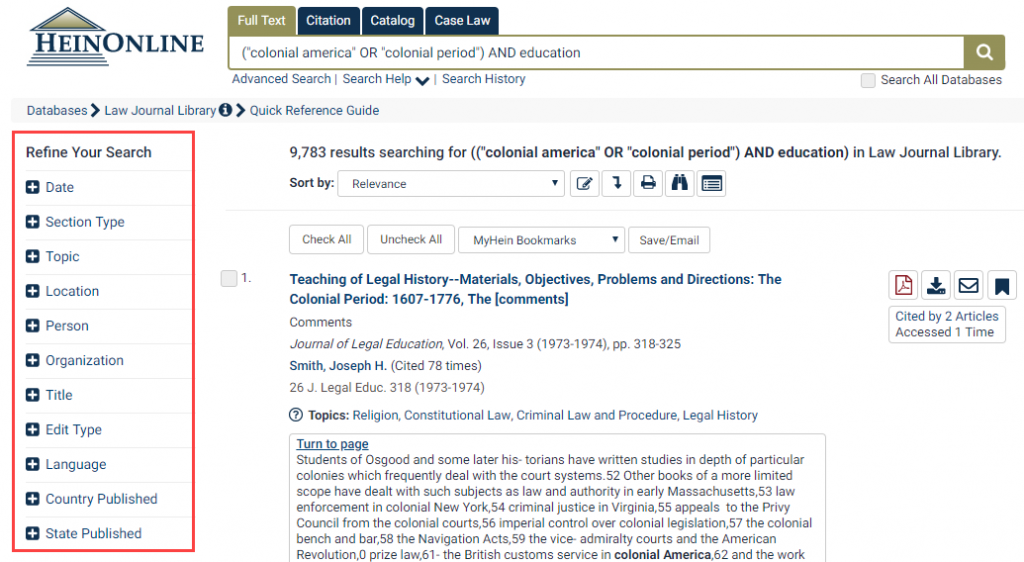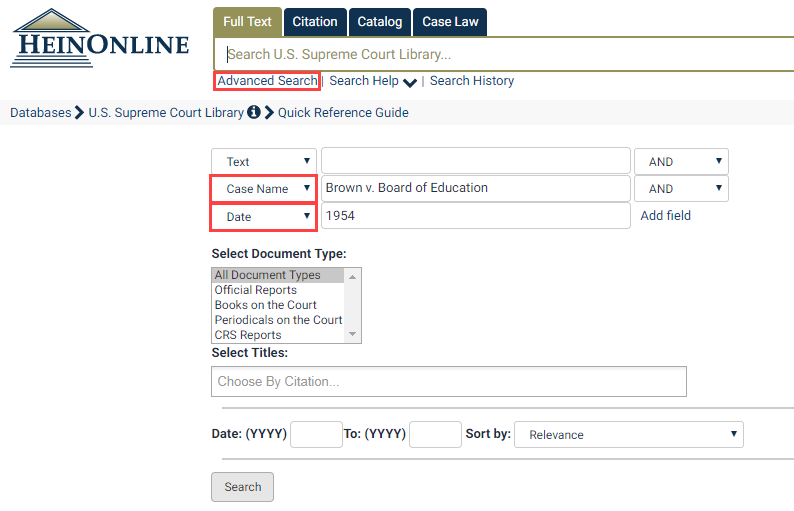HeinOnline is honoring educators of all kinds for Teacher Appreciation Week (May 5-11 2019). We thank those teachers who furthered our own development, as well as those who are currently guiding future generations. Celebrate Teachers’ Week by setting aside those lesson plans and exploring the growth of education in the United States.
Revisiting U.S. Education with HeinOnline
The United States system of education has evolved under a variety of influences dating back to the Colonial Era.
17th-18th Centuries
Compulsory education is rooted in the ideals of the Thirteen Colonies, a time when children were considered key to furthering the economic prosperity of the community. The Massachusetts School Laws of 1642, 1647, and 1648 were the first laws in the New World mandating (1) that children learn to read and write, and (2) that towns of a particular size establish public schools.
Users can easily find out more about education in Colonial America with HeinOnline. From the Law Journal Library, run a search for (“colonial america” OR “colonial period”) AND education under the “Full Text” tab to bring up almost 10,000 related results. Filter the search further by choosing any of the facets under the Refine Your Search column on the left-hand side of the page.

19th Century
In the decades following the American Revolution, a focus on education and public schooling in the U.S. increased. By the first quarter of the 19th century, one-room schoolhouses dotted the American landscape. It was not until 1837 that a statewide system of education was proposed by Horace Mann, Secretary of Education of Massachusetts. Following the Prussian model of education, Mann designed an educational system that grouped children by age, offered teacher training, and employed the “lecture method” typical of European universities, in which children received instruction from a teacher rather than actively engaging with one another. The “factory model” school of Mann’s imagination became widely popular toward the end of the 19th century, with a variation of the system established in many states thereafter.
To assist states in their establishment of effective school systems, the Department of Education was later instituted in 1867. Users can view documents from the Department of Education in HeinOnline through the U.S. Federal Agency Documents, Decisions, and Appeals database. From the database page, click the “Browse by Agency” tab and choose Department of Education (DOED) to view resources such as the “Annual Report of the U.S. Department of Health, Education, and Welfare.”

20th Century
Before World War II:
The early 20th century witnessed a rapid increase in the number of schools nationwide, as well as the number of attending students. Research from world-renowned scientists and psychologists such as Ivan Pavlov (1849-1936), Jean Piaget (1896-1980), and Maria Montessori (1870-1952) began to inform educational philosophy. During this period, educational theorist John Dewey (1859-1952) analyzed and evaluated the purpose of education, ultimately determining that rather than simply being a method of imparting knowledge, schools should also act as a means for realizing the individual potential of each student. As elementary and secondary schools increased in number, however, so did U.S. colleges and universities. To prepare their students for entrance into higher education, schools naturally adjusted their curricula with the goal being to prepare students for college, rather than for life.
After World War II:
The world at large changed after World War II, and so did the world of education. With the emergence of the baby boomer generation, schools across the U.S. saw unparalleled increases in population. New legislation for the benefit of schoolchildren appeared, such as the National School Lunch Act of 1946.
Despite unprecedented school development, inequities between schools were rampant, and particularly so for the African-American community. With the 1896 Supreme Court ruling under Plessy v. Ferguson, segregation of races in schools was considered constitutional, as long as the schools themselves offered equivalent standards of education. Nevertheless, black schools suffered from inadequate resources, funding, and facilities when compared to their white counterparts. In 1954, however, the Supreme Court’s previous ruling was overturned under Brown v. Board of Education of Topeka, with the new decision that “separate educational facilities are inherently unequal.”
Users can find Brown v. Board of Education of Topeka in HeinOnline by navigating to the U.S. Supreme Court Library database and clicking “Advanced Search,” hyperlinked in blue underneath the search bar. In the box marked Case Name, users can type “Brown v. Board of Education.” In the box marked Date, users can type “1954,” and click the search button to bring up one result.

Individuals with disabilities rose to the forefront of discussions about education in the 1970s. The Education for All Handicapped Children Act (EHA) was passed by Congress in 1975, allowing for free, accessible education to all students with disabilities. In 1986, Congress amended the law to include children of a younger age. The Individuals with Disabilities Education Act (IDEA) of 1990 expanded upon definitions outlined in the EHA and revised its language from “handicap” to “disability.”
21st Century
In 2001, Congress reauthorized and updated the Elementary and Secondary Education Act (ESEA) of 1965, which had previously provided federal funding for low-income students. This controversial reauthorization, known as the No Child Left Behind Act, initiated standards-based educational reform with the intention of closing the achievement gap. The act required that states measure the progress of their schools through standardized math and language exams, imposing penalties on those that did not demonstrate adequate yearly progress. Schools soon discovered, however, that their teachers were forced to “teach to the test” to meet the goals of the act. In addition, students with learning difficulties regularly fell short of the “proficiency” benchmark outlined by standardized tests.
To view the No Child Left Behind Act in HeinOnline, users can navigate to the U.S. Statutes at Large database and browse by Popular Name. Filtering the search by the letter “N” will bring users to a list of the acts in HeinOnline which begin with that letter. Scroll down to find the No Child Left Behind Act of 2001 115 Stat. 1425.

After reports in the early 2000s that American high school graduates did not possess the necessary skills and knowledge for employment and higher education, the National Governors Association (NGA) developed the Common Core State Standards Initiative in 2009, in conjunction with the Council of Chief State School Officers (CCSSO). The standards reflected the mathematical and linguistic knowledge that students should possess to succeed in college and their future careers. As part of the American Recovery and Reinvestment Act of 2009, the United States Department of Education funded the Race to the Top Initiative, providing an incentive for states to adopt the Common Core Standards in order to induce education reform in K-12 schools.
In 2015, the Every Student Succeeds Act (ESSA) replaced No Child Left Behind as a reauthorization of the Elementary and Secondary Education Act. In addition, ESSA explicitly prohibited the Department of Education from incentivizing or coercing states to adopt the Common Core and other standards. While 46 states initially adopted the Common Core Standards, four have withdrawn from the standards entirely, and twelve states have produced legislation to repeal the Common Core as of 2019.
We hope you enjoyed learning about the evolution of U.S. education with HeinOnline’s authoritative PDFs of American History. As the week comes to a close, don’t forget to thank a teacher!
For more great content, connect with HeinOnline on our social media platforms: Facebook, Twitter, Instagram and YouTube.



